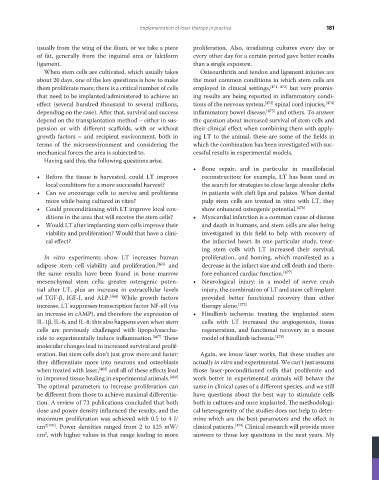Page 195 - Veterinary Laser Therapy in Small Animal Practice
P. 195
Implementation of laser therapy in practice 181
usually from the wing of the ilium, or we take a piece proliferation. Also, irradiating cultures every day or
of fat, generally from the inguinal area or falciform every other day for a certain period gave better results
ligament. than a single exposure.
When stem cells are cultivated, which usually takes Osteoarthritis and tendon and ligament injuries are
about 20 days, one of the key questions is how to make the most common conditions in which stem cells are
them proliferate more; there is a critical number of cells employed in clinical settings, [471, 472] but very promis-
that need to be implanted/administered to achieve an ing results are being reported in inflammatory condi-
effect (several hundred thousand to several millions, tions of the nervous system, [473] spinal cord injuries, [474]
depending on the case). After that, survival and success inflammatory bowel disease, [475] and others. To answer
depend on the transplantation method – either in sus- the question about increased survival of stem cells and
pension or with different scaffolds, with or without their clinical effect when combining them with apply-
growth factors – and recipient environment, both in ing LT to the animal, these are some of the fields in
terms of the microenvironment and considering the which the combination has been investigated with suc-
mechanical forces the area is subjected to. cessful results in experimental models.
Having said this, the following questions arise.
• Bone repair, and in particular in maxillofacial
• Before the tissue is harvested, could LT improve reconstruction: for example, LT has been used in
local conditions for a more successful harvest? the search for strategies to close large alveolar clefts
• Can we encourage cells to survive and proliferate in patients with cleft lips and palates. When dental
more while being cultured in vitro? pulp stem cells are treated in vitro with LT, they
• Could preconditioning with LT improve local con- show enhanced osteogenic potential. [476]
ditions in the area that will receive the stem cells? • Myocardial infarction is a common cause of disease
• Would LT after implanting stem cells improve their and death in humans, and stem cells are also being
viability and proliferation? Would that have a clini- investigated in this field to help with recovery of
cal effect? the infarcted heart. In one particular study, treat-
ing stem cells with LT increased their survival,
In vitro experiments show LT increases human proliferation, and homing, which manifested as a
adipose stem cell viability and proliferation, [465] and decrease in the infarct size and cell death and there-
the same results have been found in bone marrow fore enhanced cardiac function. [477]
mesenchymal stem cells: greater osteogenic poten- • Neurological injury: in a model of nerve crush
tial after LT, plus an increase in extracellular levels injury, the combination of LT and stem cell implant
of TGF-β, IGF-I, and ALP. [466] While growth factors provided better functional recovery than either
increase, LT suppresses transcription factor NF-κB (via therapy alone. [372]
an increase in cAMP), and therefore the expression of • Hindlimb ischemia: treating the implanted stem
IL-1β, IL-6, and IL-8; this also happens even when stem cells with LT increased the angiogenesis, tissue
cells are previously challenged with lipopolysaccha- regeneration, and functional recovery in a mouse
ride to experimentally induce inflammation. [467] These model of hindlimb ischemia. [478]
molecular changes lead to increased survival and prolif-
eration. But stem cells don’t just grow more and faster: Again, we know laser works. But these studies are
they differentiate more into neurons and osteoblasts actually in vitro and experimental. We can’t just assume
when treated with laser, [468] and all of these effects lead those laser-preconditioned cells that proliferate and
to improved tissue healing in experimental animals. [469] work better in experimental animals will behave the
The optimal parameters to increase proliferation can same in clinical cases of a different species, and we still
be different from those to achieve maximal differentia- have questions about the best way to stimulate cells
tion. A review of 73 publications concluded that both both in cultures and once implanted. The methodologi-
dose and power density influenced the results, and the cal heterogeneity of the studies does not help to deter-
maximum proliferation was achieved with 0.5 to 4 J/ mine which are the best parameters and the effect in
cm 2[470] . Power densities ranged from 2 to 125 mW/ clinical patients. [479] Clinical research will provide more
cm , with higher values in that range leading to more answers to those key questions in the next years. My
2
REDONDO PRINT (4-COL BLEED).indd 181 08/08/2019 09:49

